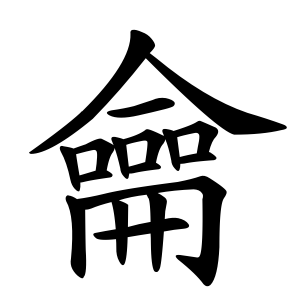龠
- yue (a Chinese flute);
Specifically, it refers to a very ancient bamboo flute with three holes that was played by blowing air through it. This type of instrument is sometimes still used in performances of ancient music.
Usage in Korean
As a radical, it generally conveys meanings related to music, musical instruments, or harmonies.
Interestingly, although 龠 already has 17 strokes, it is sometimes written with an added 竹 (bamboo) radical on top, resulting in the character 籥 (U+7C65), which also means a flute.
In ancient China, 龠 was also used as a unit of measurement in the system of weights and measures, but in modern times, it has almost entirely fallen out of use, except as a radical in Chinese characters. Even then, characters using it as a radical are extremely rare in everyday life.
Despite this, 龠 has survived in simplified Chinese, mainly because it is the radical with the most strokes (17 strokes). The character is a pictograph, modeled after a set of bamboo pipes with holes, arranged side by side like a pan flute.
Examples of characters with this radical include:
龥 (yu, "to play a wind instrument"),
龡 (chui, "to blow"),
龢 (he, "to harmonize") — rarely used except as an archaic or calligraphic variant of 和 ("harmony").
Among all radicals, 龠 is the one with the most strokes (17), making it one of the most complex and least commonly used radicals today.
- 人一口月 (OMRB)
- ⿳ 亼 𠱠 𠕁
